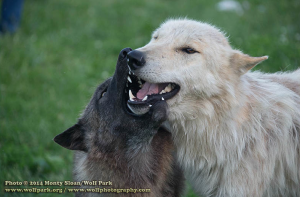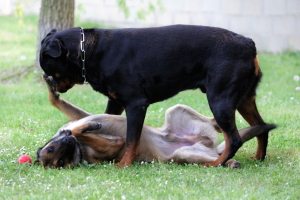 Dog lovers from all walks of life are often convinced that they have a fairly strong understanding of dog behavior. From the dog guardians to the dog professionals, most feel confident about interpreting canine behavior and are quick at dispensing training advice. Groomers, pet store salesmen, dog walkers, dog owners, dog trainers, with or without any formal education about canines, all have strong opinions and beliefs about dog training and behavior. But how valid are those beliefs? Dog guardians are flooded with conflicting information and as a result, often resort to their own concoction of training strategies, mostly influenced by TV shows and popular ideas. To make matters worse, there is a great divide amongst dog professionals. Between traditional and positive trainers, there is a separation in training principles and a fundamental disagreement in the basic interpretation of canine behavior. So much so, that both camps often avoid discussing certain subjects of contention altogether and stick to their own circle of likeminded people.
Dog lovers from all walks of life are often convinced that they have a fairly strong understanding of dog behavior. From the dog guardians to the dog professionals, most feel confident about interpreting canine behavior and are quick at dispensing training advice. Groomers, pet store salesmen, dog walkers, dog owners, dog trainers, with or without any formal education about canines, all have strong opinions and beliefs about dog training and behavior. But how valid are those beliefs? Dog guardians are flooded with conflicting information and as a result, often resort to their own concoction of training strategies, mostly influenced by TV shows and popular ideas. To make matters worse, there is a great divide amongst dog professionals. Between traditional and positive trainers, there is a separation in training principles and a fundamental disagreement in the basic interpretation of canine behavior. So much so, that both camps often avoid discussing certain subjects of contention altogether and stick to their own circle of likeminded people.
So how do we sort valid information from conventional belief? The only way is to put those beliefs to the test. Science doesn’t care about who’s right and who’s wrong. Through systematic observations and experimentation, scientists decode our dogs’ behavior, measure the influence of environmental stimuli, assess which methods work, etc. Science is a fluid process in constant evolution, where ideas and hypothesis are constantly challenged and revisited. It’s our best tool towards objective understanding of very complex systems. With the increase in scientific interest of canine behavior, we finally have access to validated data. Even better, science is made available to all dog lovers by the Society for the Promotion of Applied Research in Canine Science (SPARCS). This recent conference in Newport RI was once again broadcast for FREE to all dog lovers across the world and was a fantastic opportunity to learn about the latest scientific advancements on the subject. This year, SPARCS 2014 focused on 3 main themes: 1) conflict & aggression, 2) temperament and personality 3) science in training.
Without going into all of the presentations, let me review some of the points discussed during the conference.
 “We talk about aggression as if it’s a bad thing yet natural selection supports some forms of aggression. Animals are aggressive to protect food or feeding territories, to protect mates or to protect themselves” explains Ray Copinger Ph.D.. Agonistic behaviors are there to prevent or resolve conflicts emphasizes Patricia McConnell, Ph.D. We have identified even the very subtle signals dogs emit in those situations, but we run into problems in their interpretations and it can be confusing. Whatever we call them, social animals need these displays. An animal’s behavior is driven by the limited resource of energy, so one of the functions of these behaviors is to save energy and to get information passed on quickly. Many have interpreted the dog’s social behavior based on wild canids. Research today shows that some of the ideas we had on wolf hierarchy were not necessarily true. Contrary to wild canids, dogs live in very diverse environments. They are much more variable than wild canid species says McConnell. So it’s not that dogs don’t create a social hierarchy, but their predisposition to do so is highly variable. It matters to some dogs, not so much to others. The same applies to territorial behaviors. The use of the terms dominance or territorial aggression is more problematic than helpful when talking about dogs since their behavior is so context specific and variable. We need to be more thoughtful about the words we use as they have a direct influence on how we react to them.
“We talk about aggression as if it’s a bad thing yet natural selection supports some forms of aggression. Animals are aggressive to protect food or feeding territories, to protect mates or to protect themselves” explains Ray Copinger Ph.D.. Agonistic behaviors are there to prevent or resolve conflicts emphasizes Patricia McConnell, Ph.D. We have identified even the very subtle signals dogs emit in those situations, but we run into problems in their interpretations and it can be confusing. Whatever we call them, social animals need these displays. An animal’s behavior is driven by the limited resource of energy, so one of the functions of these behaviors is to save energy and to get information passed on quickly. Many have interpreted the dog’s social behavior based on wild canids. Research today shows that some of the ideas we had on wolf hierarchy were not necessarily true. Contrary to wild canids, dogs live in very diverse environments. They are much more variable than wild canid species says McConnell. So it’s not that dogs don’t create a social hierarchy, but their predisposition to do so is highly variable. It matters to some dogs, not so much to others. The same applies to territorial behaviors. The use of the terms dominance or territorial aggression is more problematic than helpful when talking about dogs since their behavior is so context specific and variable. We need to be more thoughtful about the words we use as they have a direct influence on how we react to them.
 Talking about dominance in other species is not a controversial subject. Dominance is a prediction of who’s going to get the resource, the food, the female in heat, etc. It’s about a relationship in a competitive situation, that’s all. The point is to avoid aggression. It is not about control or aggression. When talking about dogs however, the term ‘dominance’ is loaded. This is one of the biggest sticking points between dog trainers. A dog not coming when called has nothing to do with dominance. The concept of dominance is not relevant in training and should not justify the use of force. Scientists use the term dominance in describing certain social interactions, but do not use the term ‘alpha’ anymore. So it’s not that dominance in dogs does not exist, it simply isn’t relevant in the way some dog trainers apply it. And in general, this concept does not help us understand our dogs better according to McConnell. When it comes to aggression for instance, studies show that aggression towards strangers is strongly correlated to fear of strangers (James Serpell Ph.D.). Here again, interpreting aggression in terms of dominance will only lead to solutions that will increase the underlying emotion of fear, not diminish it.
Talking about dominance in other species is not a controversial subject. Dominance is a prediction of who’s going to get the resource, the food, the female in heat, etc. It’s about a relationship in a competitive situation, that’s all. The point is to avoid aggression. It is not about control or aggression. When talking about dogs however, the term ‘dominance’ is loaded. This is one of the biggest sticking points between dog trainers. A dog not coming when called has nothing to do with dominance. The concept of dominance is not relevant in training and should not justify the use of force. Scientists use the term dominance in describing certain social interactions, but do not use the term ‘alpha’ anymore. So it’s not that dominance in dogs does not exist, it simply isn’t relevant in the way some dog trainers apply it. And in general, this concept does not help us understand our dogs better according to McConnell. When it comes to aggression for instance, studies show that aggression towards strangers is strongly correlated to fear of strangers (James Serpell Ph.D.). Here again, interpreting aggression in terms of dominance will only lead to solutions that will increase the underlying emotion of fear, not diminish it.
Compared to any other species, dogs have developed an exceptional ability to read and respond to human’s intentions and behavior according to Serpell. As a consequence, they will adapt their behavior to the subtle changes in their guardians’ personality and mental state. This comes to a great benefit to our ability to communicate with our canine companions, but may also be an underlying factor to certain behavior problems. As an example, one study showed that owners of cocker spaniels with aggression issues also tended to be more stressed and frustrated, less stable, more shy and/or less disciplined. It’s possible that through their interaction with their pet, anxious, stressed out, and neurotic guardians will induce aggression in their dogs. Being overprotective for instance, may lead to failure in properly socializing their pet (Podberscek & Serpell, 1997). In general, the less confident or independent-minded the guardian, the more the dog displayed behavior problems such as certain forms of aggression or separation anxiety (Dodman & al., 2003). Amongst handlers of search and rescue dogs, those with PTSD and depression symptoms had dogs with more separation problems and attachment/attention-seeking issues at 1 year old. Depression in the handler also increased the chances of dog-directed aggression in their dogs at 2 years of age. A study with guide dogs also showed that when the handler is more agreeable and conscientious they use fewer corrections and rate their dog as more responsive to corrections (Hunt, 2012). In other words, what all these different studies confirm is, that the handler’s personality is associated with the dog’s behavior. This leads to question the suitability of certain personality types to own or work with dogs altogether. Not everybody should own a dog according to Serpell.
 When training working dogs understanding the underlying principles at play is absolutely critical. In his presentation on scent detection training, Simon Gadbois Ph.D. emphasized the need for good practices in training as well as standardized protocols. There are too many trainers who make up their own training routine without a solid understanding of learning theory and/or olfactory psychophysics. In dog training and in scent detection in particular, there is a ‘need for good science to determine the validity, reliability, accuracy (sensitivity and specificity) of canine detection says Gadbois. ‘Working with an intangible, invisible, often undetectable set of stimuli is challenging for humans. It requires knowledge of obscure areas of science: fluid dynamics, psychophysics, microclimatology and micrometeorology, analytical chemistry, etc.”
When training working dogs understanding the underlying principles at play is absolutely critical. In his presentation on scent detection training, Simon Gadbois Ph.D. emphasized the need for good practices in training as well as standardized protocols. There are too many trainers who make up their own training routine without a solid understanding of learning theory and/or olfactory psychophysics. In dog training and in scent detection in particular, there is a ‘need for good science to determine the validity, reliability, accuracy (sensitivity and specificity) of canine detection says Gadbois. ‘Working with an intangible, invisible, often undetectable set of stimuli is challenging for humans. It requires knowledge of obscure areas of science: fluid dynamics, psychophysics, microclimatology and micrometeorology, analytical chemistry, etc.”
The big lesson from these three days at SPARCS comes from Monique Udell Ph.D.:
“Science is a process. Knowledge evolves and we have to be willing to shift and change.” Most of all: “Failure to discuss scientific pros and cons of all options prevents us from being able to present even the best methods”, she says. “We should never have to be afraid of presenting information based on science, reason and experience, including information about punishment and aversive control whether or not we agree with its use. Aversive control works and it sometimes works faster than positive reinforcement, making it incredibly reinforcing to the person implementing it. As professionals, we know there are real side effects to punishment and negative reinforcement. There are also right and wrong ways to use it. A failure to talk about this subject openly, often for fear of prejudice, prevents us from making the strongest scientifically based argument for the use of positive methods, even when positive methods may be the best option. It also prevents us from discussing when and how positive punishment and negative reinforcement may be an effective option and how it can be used effectively while minimizing harm and negative side effects. Not all forms of punishment are cruel and harmful. If we are not willing to educate the public, there are plenty of programs on TV that will and that information may not be scientifically sound. When we fail to present information about both sides upfront, frustrated owners may turn to aversive control to expedite results or as a last result without any sound knowledge or professional guidance about techniques or the dangers of implementing aversive control incorrectly. We need to backup our opinions with scientific evidence and experience, not with emotion.”
Jennifer Cattet Ph.D.


Excellent article, Jennifer! I hope pet owners and pet professionals alike will read this and learn something!
I have always believed that my dogs fed/feed off my energy, even if I didn’t know how to express that belief. But I also bought into the current popular training methods — some of which were not ideal for my dogs. Then I took the Animal Behavior College’s Dog Obedience Training Instructor course. I learned a great deal from that course and am proud of having earned my certificate even though I’ve decided not to make a career of training only a few years away from “normal retirement age”. If nothing else, I have at least learned to balance my own dogs’ training to best fit their individual learning styles and physical abilities and limitations, as well as with what behaviors are acceptable and not acceptable to ME.
Great article..thanks for sharing.
“Energy” is a very misunderstood term. In truth the “energy” that our dogs pick up on is very much tangible and observable, though perhaps not so easily by us. Dogs (and animals in general but dogs especially) are usually very sensitive to our moods, our behavior and even our health! They notice things we don’t, in our body language, our tone, scent, and who knows what else! There’s nothing mystical about it.
That being said it’s clear that Jennifer is one of the most credible and reasonable individuals to post on these controversial matters, and I feel, the one who speaks the most truth.